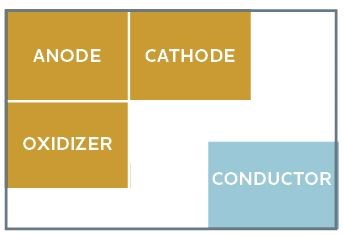Post-Cleaning Corrosion Prevention
To keep corrosion away, understand that cleaning, passivation and corrosion protection are separate activities with distinct functions.
In an industry where competition among machine shops can be fierce, it’s critical to produce parts that are high quality and will stay that way for as long as possible. However, there are some obstacles that stand in the way of longevity and corrosion is one of them. Corrosion is the process by which metal surfaces are modified to form an oxidation product such as rust.
To understand how corrosion works, consider the Corrosion Square. The parts of the corrosion square (Fig. 1) consist of an anodic area that supplies electrons, a cathodic area that consumes electrons, a conducting path between the two and oxygen or an oxidizing chemical. To forestall corrosion, remove at least one component of the square (Fig. 2).
Surface preparation, notably critical cleaning, must be understood and managed properly. Otherwise, the corrosion square slips back together and corrosion happens. One key to success is understanding that cleaning, passivation and corrosion protection are separate activities with distinct functions. Cleaning is removing soil or unwanted matter, without damaging the surface. Passivation, typically surface treatment with an acid, is a modification that leaves the surface less susceptible to corrosion. The notion that passivation can replace cleaning is not true. If the soils are polar, such as salts, then passivation may be enough.
However, if metalworking fluids are used, usually non-polar, organic compounds are present. Acid treatment won’t remove most surface soils that accumulate during metal forming or fabrication. In fact, cleaning with water alone and then passivating is an invitation to corrosion. If the surface is not clean enough, passivation will not be consistent. There will likely be poor coating adhesion, leading to rejoining of the conductive portion to the corrosion square.
To effectively remove most soils, aqueous cleaning processes use basic (high pH) or sometimes near-neutral cleaning agents. Solvent cleaning is sometimes preferred, on the grounds that aqueous processes leave a part “too clean.” This is because while cleaning is an essential part of surface preparation, the soil, notably the metalworking fluid, acts as a non-conductive coating. The more effective the soil removal, the higher the potential for corrosion.
It is becoming more difficult to clean a product, in part because metalworking fluids have evolved and leave more residue. Manufacturers used to use “vanishing oils.” These oils left some residue on the part that protected the product from corrosion. The downside was that the oils vanished into the air, resulting in pollution. Given environmental mandates, metalworking fluids were reformulated to be less evaporative, which means they leave more complex residue on the part. This residue can interfere with subsequent assembly, coating and finishing operations and must be removed using aggressive cleaning, resulting in a surface that is susceptible to corrosion.
One solution is to clean and then forestall corrosion using a corrosion inhibitor to reduce conduction. However, any corrosion inhibitor is adding a contaminant to the surface. The right corrosion inhibitor depends on the customer. In an era of increased cleaning costs and diverse customer requirements, those who fabricate, stamp or machine metal parts may, out of necessity, avoid making a decision about the correct cleaning process or the optimal corrosion inhibitor. The machinist may not do any cleaning and/or may supply the product packed in oil. In this case, cleaning processes may require higher temperatures, stronger physical forces, and longer cleaning and rinsing times than normal. More aggressive cleaning can lead to corrosion susceptibility.
For complex supply chains, the customizing corrosion protection for a range of customers may require finesse. However, where there is a captive or dedicated machine shop, there is a simple, radical solution: communicate and coordinate!
Related Content
In-line Monitoring for Automated Immersion Cleaning Systems
Ecoclean’s Acoustic Performance Measurement (APM) system provides in-line measurement of ultrasonic frequency and power in fully automated immersion cleaning systems on a batch-by-batch basis or at defined time intervals, such as once a shift, day or week.
Read MoreKyzen Solvents Provide Ease of Cleaning for Medical Parts
The Metalnox line of solvent products are designed to improve reliability and increase the ease of cleaning in vacuum and vapor degreasing processes.
Read MoreIndustrial Cleaning Shop Zeros In on Precision
This parts cleaning company is elevating its efforts to become a technical cleanliness expert, which presents an exciting, yet sometimes arduous, journey. The ongoing education of the team as well as significant investments in equipment and processes attribute to this shop’s success.
Read MoreVersatile Sandblasting for Deburring Intricate Geometries
PMTS 2023: Comco’s MicroBlasting sandblasting systems can deburr, texture and clean small, intricate parts.
Read MoreRead Next
A Tooling Workshop Worth a Visit
Marubeni Citizen-Cincom’s tooling and accessory workshop offers a chance to learn more about ancillary devices that can boost machining efficiency and capability.
Read MoreEmerging Leaders Nominations Now Open
Here’s your chance to highlight a young person in your manufacturing business who is on the path to be a future leader moving your company forward.
Read MoreDo You Have Single Points of Failure?
Plans need to be in place before a catastrophic event occurs.
Read More















.jpg;maxWidth=300;quality=90)









